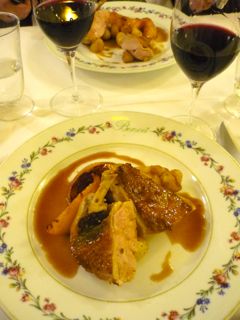The Hotel Le Rapp is nicely located near the center of Colmar, but in a quiet location. It’s a good size room with lots of hot water and the bed is firm yet comfortable. All good things, but sleep still escaped me. So, up early to take the train to Strasbourg with the plan to be onsite to see/hear the cathedral chimes around 12:30.
 |
| Gare de Strasbourg |
Ride to Strasbourg was quick and uneventful. Strasbourg train station is a big bubble. It was a gloomy, gray day, which did nothing to help the city stand out. It certainly doesn’t hold the charm of Colmar, but then again, it is a much larger city. The star of Strasbourg is its cathedral (Cathédrale de Notre-Dame), a perfect example of delicate Gothic architecture. Its pink/red sandstone coloring is almost as famous as the Cathedral.
However, it is the height of the structure that is most imposing. The Cathedral was begun in 1176 and finished in 1429. It was the tallest Cathedral in the world at its completion. Can you just imagine what the impact of this imposing structure might have been on its medieval visitors? I found it overwhelming even surrounded as it was by other tall structures. The Cathedral still holds the position of third tallest Cathedral in the world today. Which is pretty amazing considering it has survived – the French Revolution, the Franco-Prussian War, World War I, and World War II.
 As I stood in front of this imposing structure on the Roman square that fronts it (at over 2,000 years old it’s spectacular on it’s own right), and look left, a dark, half-timbered building caught my eye. It’s actually quite hard to miss given the light coloring of all the other buildings that surround the square. It was the home of a wealthy merchant in the 16th century. The building has been left intact, as citizens of the city believe it symbolizes the capitalism on which the city was built and still prides itself. Located at the crossroads of Europe and the Rhine River, Strasbourg took advantage of its medieval location by taxing goods passing through. This robust economy helped pay for the cathedral.
As I stood in front of this imposing structure on the Roman square that fronts it (at over 2,000 years old it’s spectacular on it’s own right), and look left, a dark, half-timbered building caught my eye. It’s actually quite hard to miss given the light coloring of all the other buildings that surround the square. It was the home of a wealthy merchant in the 16th century. The building has been left intact, as citizens of the city believe it symbolizes the capitalism on which the city was built and still prides itself. Located at the crossroads of Europe and the Rhine River, Strasbourg took advantage of its medieval location by taxing goods passing through. This robust economy helped pay for the cathedral. |
| l'Horlogie |
 |
| The Organ |
 |
| The Pulpit |
 |
| Stain-glass Window |
Since Strasbourg is situated along the Rhine River we thought a stroll along that waterway the next best thing on our agenda. As you recall, Colmar has an area called the Petit Venise, well, Strasbourg’s answer is Le Petit France. A pretty canal/lock system that is adjacent to the Rhine. We wandered this area enjoying the flowered window boxes and bridges until the sky opened up. Weather has been hit and miss rain this trip and this was a hit, major hit.
 |
| Homes along the Rhine |
 |
| The Petit France intrigues Betty |
Back in Colmar the rain had found its way here as well. We decided to take a very late dejeuner (lunch) at a Wistub on the canal in Petit Venise. We enjoyed – Tarte Oignon avec salade verte and a glass each of Edelzwicker. Our lunch was lovely. At the end they brought a couple of candies. Popping them into our mouths we were taken back – eucalyptus cough drops had nothing on these things. But we were informed they were a digestif (the Alsatians are quite focused on how things move out of the body apparently).
We took a stroll in the rain that was much lighter than in Strasbourg and finally ended up back at the hotel. Since the weather wasn’t cooperating, we decided to spend the rest of the afternoon in the room catching up on work and the blog. We did pop out later to the Monoprix (grocery store) and picked up wine, a couple of Alsatian cheeses (tome & muenster), honeycrunch apples, bananas, and a ciabatta with green olives. Took it back to the room for our evening repast.
And so ends the Strasbourg day...











































